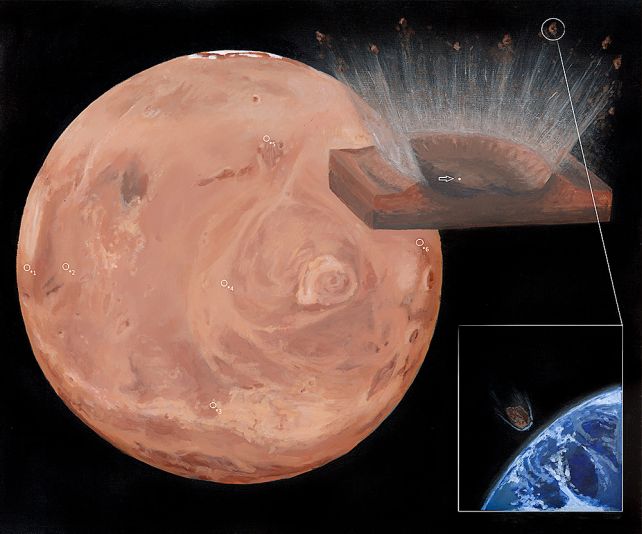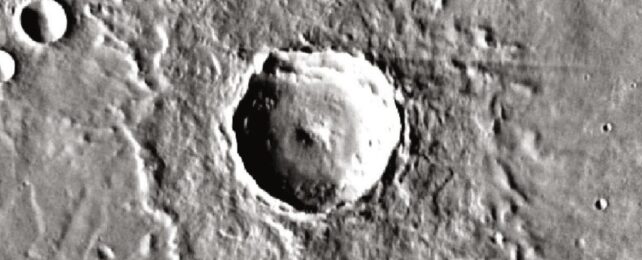Earth and Mars will, hopefully, never meet, but that doesn't mean they can't engage in a little exchange program. Thanks to the often violent nature of the Solar System, material that has been blasted off Mars can make its way across the gulf of space to end up smashing into Earth. (It's unclear if Earth returned the favor.)
To date, some 390 meteorites have been found that originated on the red planet. That might sound like a lot, but it's just a small fraction of the more than 83,000 meteorites we've recovered on Earth. And scientists have just traced 200 of those meteorites to their place of origin on the surface of Mars.
Surprisingly, all 200 were ejected from just five impact craters, found in two regions of Mars – Tharsis and Elysium.
"Now, we can group these meteorites by their shared history and then their location on the surface prior to coming to Earth," says geologist Christopher Herd of the University of Alberta in Canada.
"It allows us to say, of all these potential craters, we can narrow them down to 15, and then from the 15 we can narrow them down even further based on specific meteorite characteristics."
It's not an easy journey for a rock to get to Earth from Mars. First, a large rock needs to slam powerfully into the surface of Mars, excavating a huge crater, and sending Martian rocks flying with enough force to achieve escape velocity.
Then, the trajectory of that debris needs to carry it to Earth, a journey that can take millions of years. Finally, when the rock arrives, it has to survive the heat and pressure of atmospheric entry, and slam into Earth's surface.
Luckily, when the rock does arrive, we can study its properties to match it up with meteorites that have similar properties to determine which rocks belong together as members of the same impact event and journey to Earth.
These properties include age and composition, as well as whether the signature of the Martian atmosphere that becomes embedded in the rock matches the atmospheric signature obtained from the Viking Mars lander decades ago.
Identifying where on Mars the rock itself originated is a little trickier. To do so with absolute confidence, we'd need the rock's trajectory through space, and samples of the impact crater on Mars – and, for most rocks, we just have no way to access that data.
We can, however, make estimates, based on the properties of the rock and the surface geology of Mars.
In order to determine the birthplaces of five groups of Martian meteorites, Herd and his colleagues used advances in techniques such as remote sensing, modeling, and crater chronology – that is, working out the ages of the craters on Mars, and matching that data up with Martian meteorites.

With the mineral profile of the meteorite groups at hand, the researchers went looking for locations on the surface of Mars that matched their profile. Most Martian meteorites are igneous, so that involves looking for volcanic regions of Mars whose age and mineral composition align with the age and mineral composition of the material in the meteorites.
The other thing to look for is craters of the right age. All 10 groups of Martian meteorites were ejected between 600,000 and 20 million years ago. And, by looking at the rocks themselves, and the fact that they were flung hard enough to reach Earth, Herd and his team were able to create models of the impacts that sent them flying – which, in turn, can help identify their original craters.
"One of the major advances here is being able to model the ejection process, and from that process be able to determine the crater size or range of crater sizes that ultimately could have ejected that particular group of meteorites, or even that one particular meteorite," says Herd.
"I call that the missing link — to be able to say, for example, the conditions under which this meteorite was ejected were met by an impact event that produced craters between 10 and 30 kilometers [12 to 19 miles] across."
The researchers were able to narrow down the possibilities for one group of meteorites to a single crater. For the remaining four groups, several candidates were identified each, but all five could be narrowed down to either the Tharsis or Elysium volcanic regions.
By adding additional constraints to future research, the locations can be narrowed down even further – giving us a spectacular tool for studying Mars with precision.
"We can maybe even reconstruct the volcanic stratigraphy, the position of all these rocks, before they got blasted off the surface. It is really amazing if you think about it. It's the closest thing we can have to actually going to Mars and picking up a rock," Herd says.
"The idea of taking a group of meteorites that were all blasted at the same time and then doing targeted studies on them to determine where they were prior to being ejected – that to me is the exciting next step. This will fundamentally change how we study meteorites from Mars."
The research has been published in Science Advances.
